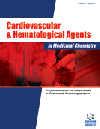- Home
- A-Z Publications
- Cardiovascular & Hematological Agents in Medicinal Chemistry (Formerly Current Medicinal Chemistry - Cardiovascular & Hematological Agents)
- Previous Issues
- Volume 19, Issue 2, 2021
Cardiovascular & Hematological Agents in Medicinal Chemistry (Formerly Current Medicinal Chemistry - Cardiovascular & Hematological Agents) - Volume 19, Issue 2, 2021
Volume 19, Issue 2, 2021
-
-
Pharmacological Uses of the Plants Belonging to the Genus Commiphora
More LessAuthors: Subbiah Latha, Palanisamy Selvamani and Thangavelu PrabhaNatural products have a unique place in the healthcare industry. The genus Commiphora emerged as a potential medicinal source with huge benefits as evidenced through its use in various traditional and modern systems of medicine. Therefore, we aimed to prepare a concise review on the pharmacological activities and the indigenous uses of various plant species belonging to the genus Commiphora along with the struc Read More
-
-
-
Bioactive Compounds in Diabetic Cardiomyopathy: Current Approaches and Potential Diagnostic and Therapeutic Targets
More LessAuthors: Sandeep K. Kotturu, Veera V.S. Uddandrao, Sudip Ghosh and Brahmanaidu ParimBackground: Diabetic Cardiomyopathy (DCM) has an adverse effect on health and occurs with or without concurrent vascular disease. Although several pathological mechanisms have been implicated in DCM, oxidative stress is widely thought to be the foremost cause for DCM pathogenesis. Objective: In this review, we focused on the role of bioactive compounds from different sources such as plant and marine products in ca Read More
-
-
-
Potential Antimicrobial Peptides Elucidation from the Marine Bacteria
More LessAuthors: Adyasa Barik, Pandiyan Rajesh, Manthiram Malathi and Vellaisamy BalasubramanianIn recent years, excessive use of antibiotics has been raising its head to a serious problem all around the world, as pathogens become drug-resistant and create challenges to the medical field. This failure of the most potent antibiotics that kill pathogens increases the thirst for researchers to look for another way of killing pathogens. It has led to the findings of antimicrobial peptide, which are the most potent pe Read More
-
-
-
A Review on Pharmacological Activities and Active Phytoconstituents of Roadside Trees of Tamil Nadu
More LessAuthors: Arunambiga Subramaniam, Praveena Alagaraj and Balakrishnan ArumugamRoadsides are habitats with very specific environmental conditions, often substantially differing from their natural surroundings. Roadside trees provide a home for many floral and faunal species and have many environmental benefits including removing air pollutants, supporting wildlife, etc. Many medicinal plants including roadside trees have been discovered and traditionally they are being used for treating many kinds of dis Read More
-
-
-
Hepatoprotective Effect of Azolla microphylla on Isoproterenol-induced Rats and the Identification of Active Compound through HPTLC and GC-MS Analysis
More LessAim: To study the pretreatment effect of ethanolic extract of Azolla microphylla (EAM) on rat liver induced with Isoproterenol (ISO) and to identify the phytochemicals present in EAM using HPTLC and GC-MS techniques. Materials and Methods: 42 male Wistar rats were divided into 7 groups. Rats were pre-treated with EAM (250 and 500 mg/kg bw) orally for 28 days and induced with ISO (85 mg/kg; intra-peritoneal) on the 29t Read More
-
-
-
Pathophysiology of Cardiovascular Diseases and the Role of Vitamins, and Herbal Extracts in the Reduction of Cardiovascular Risks
More LessBackground: Heart disease (cardiovascular disease: CVD) is considered the leading cause of worldwide death. These diseases are recognized as group of disorders which are related to heart and blood vessels. Generally, heart diseases are considered life style associated diseases but many other factors are also found associated with cardiovascular diseases. Objective: The aim of this review is to provide the till date informat Read More
-
-
-
Antithrombotic / Antiplatelet Therapy in Patients with Stable Coronary Artery Disease and After Acute Coronary Syndrome
More LessAuthors: Jose B. Cruz Rodriguez, Kunal Mishra and Tariq SiddiquiThe major physiopathological mechanism underlying Acute Coronary Syndromes (ACS) is atherosclerotic plaque rupture with resultant coronary thrombosis, posing a big burden in health care systems. Dual anti-platelet therapy (DAPT) can improve CV outcome with a prolonged regimen, albeit at the cost of increased bleeding rates. We performed a narrative literature review on the topic, in which we explored databases t Read More
-
Volumes & issues
-
Volume 23 (2025)
-
Volume 22 (2024)
-
Volume 21 (2023)
-
Volume 20 (2022)
-
Volume 19 (2021)
-
Volume 18 (2020)
-
Volume 2 (2020)
-
Volume 17 (2019)
-
Volume 16 (2018)
-
Volume 15 (2017)
-
Volume 14 (2016)
-
Volume 13 (2015)
-
Volume 12 (2014)
-
Volume 11 (2013)
-
Volume 10 (2012)
-
Volume 9 (2011)
-
Volume 8 (2010)
-
Volume 7 (2009)
-
Volume 6 (2008)
-
Volume 5 (2007)
-
Volume 4 (2006)
Most Read This Month
Article
content/journals/chamc
Journal
10
5
false
en


